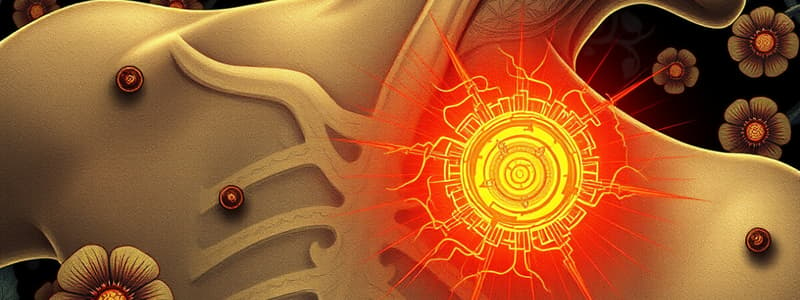Podcast
Questions and Answers
What type of receptors respond specifically to chemical ligands?
What type of receptors respond specifically to chemical ligands?
- Photoreceptors
- Thermoreceptors
- Mechanoreceptors
- Chemoreceptors (correct)
Which sensory receptor responds to temperature changes?
Which sensory receptor responds to temperature changes?
- Photoreceptors
- Rheoreceptors
- Thermoreceptors (correct)
- Mechanoreceptors
Which of the following receptors is involved in the sense of hearing?
Which of the following receptors is involved in the sense of hearing?
- Thermoreceptors
- Mechanoreceptors (correct)
- Chemoreceptors
- Nociceptors
What structure is typically involved in the transmission of sensory information for specialized receptors?
What structure is typically involved in the transmission of sensory information for specialized receptors?
Which type of sensory neuron receptive field is found in more sensitive areas of the body?
Which type of sensory neuron receptive field is found in more sensitive areas of the body?
What is the role of synaptic vesicles in sensory receptors?
What is the role of synaptic vesicles in sensory receptors?
What kind of nerve endings are associated with pain and itch sensations?
What kind of nerve endings are associated with pain and itch sensations?
For visual stimuli, which receptors are activated?
For visual stimuli, which receptors are activated?
The convergence of sensory neurons results in what type of receptive fields?
The convergence of sensory neurons results in what type of receptive fields?
What type of receptors senses steady pressure and texture?
What type of receptors senses steady pressure and texture?
Which sensory receptor is primarily responsible for sensing vibrations?
Which sensory receptor is primarily responsible for sensing vibrations?
What happens to the area of the brain that represents a lost finger?
What happens to the area of the brain that represents a lost finger?
What type of sensory information do free nerve endings of nociceptors primarily respond to?
What type of sensory information do free nerve endings of nociceptors primarily respond to?
What is the function of Meissner's corpuscles?
What is the function of Meissner's corpuscles?
Which part of the body does the thalamus relay sensory signals from?
Which part of the body does the thalamus relay sensory signals from?
What determines the duration of a series of action potentials in response to a stimulus?
What determines the duration of a series of action potentials in response to a stimulus?
Which type of receptors are primarily associated with continuous monitoring of bodily parameters?
Which type of receptors are primarily associated with continuous monitoring of bodily parameters?
What is the function of receptor adaptation?
What is the function of receptor adaptation?
Which of the following is NOT considered a modality of somatic senses?
Which of the following is NOT considered a modality of somatic senses?
What type of stimulus would a baroreceptor respond to?
What type of stimulus would a baroreceptor respond to?
Which of the following stimuli would likely lead to receptor adaptation?
Which of the following stimuli would likely lead to receptor adaptation?
Which sense is mainly associated with nociception?
Which sense is mainly associated with nociception?
How does the body typically respond to stimuli that threaten homeostasis?
How does the body typically respond to stimuli that threaten homeostasis?
What would be a likely characteristic of a phasic receptor?
What would be a likely characteristic of a phasic receptor?
Which of the following modalities would you associate with proprioception?
Which of the following modalities would you associate with proprioception?
What leads to the formation of a secondary receptive field?
What leads to the formation of a secondary receptive field?
What happens when fewer neurons converge in sensory pathways?
What happens when fewer neurons converge in sensory pathways?
How are simultaneous subthreshold stimuli processed?
How are simultaneous subthreshold stimuli processed?
Why do two stimuli within the same secondary receptive field appear as a single point?
Why do two stimuli within the same secondary receptive field appear as a single point?
What is the result of two-point discrimination on the skin surface?
What is the result of two-point discrimination on the skin surface?
What occurs when two points fall outside the overlapping secondary receptive fields?
What occurs when two points fall outside the overlapping secondary receptive fields?
How does convergence affect the perception of stimuli?
How does convergence affect the perception of stimuli?
What is the implication of having smaller secondary receptive fields?
What is the implication of having smaller secondary receptive fields?
What role do secondary sensory neurons play in the perception of stimuli?
What role do secondary sensory neurons play in the perception of stimuli?
What does the term 'two-point discrimination' refer to?
What does the term 'two-point discrimination' refer to?
What phenomenon enhances the perception of a stimulus?
What phenomenon enhances the perception of a stimulus?
Which of the following describes how stimulus intensity is coded?
Which of the following describes how stimulus intensity is coded?
What is the main function of tonic receptors?
What is the main function of tonic receptors?
How is the duration of a stimulus coded?
How is the duration of a stimulus coded?
What happens to some receptors during prolonged exposure to a stimulus?
What happens to some receptors during prolonged exposure to a stimulus?
What occurs when the strength of a stimulus increases?
What occurs when the strength of a stimulus increases?
Which term describes receptors that respond strongly to changes in stimulus intensity?
Which term describes receptors that respond strongly to changes in stimulus intensity?
What does the term 'frequency coding' refer to in the context of sensory systems?
What does the term 'frequency coding' refer to in the context of sensory systems?
What role do lateral neurons play in perception?
What role do lateral neurons play in perception?
Which aspect of action potentials is less affected when comparing tonic and phasic receptors?
Which aspect of action potentials is less affected when comparing tonic and phasic receptors?
Flashcards are hidden until you start studying
Study Notes
Sensory Receptors Overview
- Types of Sensory Receptors: Include chemoreceptors (taste, smell), mechanoreceptors (pressure, sound, hearing), thermoreceptors (temperature), and photoreceptors (vision).
- Free Nerve Endings: Unmyelinated axons responsible for detecting pain and itch sensations.
- Receptor Types: Specialized cells, such as hair cells in the ear, release neurotransmitters to sensory neurons, generating action potentials.
Receptive Fields
- Convergence Effect: Multiple primary sensory neurons can converge, resulting in larger receptive fields for less sensitive areas, leading to a reduced ability to discriminate between two stimuli (two-point discrimination).
- Secondary Receptive Fields: Smaller fields are formed with fewer converging neurons, allowing for better discrimination of stimuli.
Properties of Stimulus
- Intensity Coding: Determined by the number of activated receptors and the frequency of action potentials (frequency coding).
- Duration Coding: Implied by the duration of action potentials; receptors can adapt and cease responding to sustained stimuli.
- Tonic vs. Phasic Receptors: Tonic receptors continuously monitor certain parameters (e.g., blood pressure), while phasic receptors respond only briefly to changes in stimuli.
Action Potentials and Receptor Adaptation
- Action Potential Response: The frequency of action potentials correlates with the intensity of the stimulus; duration varies with the pattern of action potentials at the axon terminal.
- Receptor Adaptation: Allows the body to ignore non-threatening stimuli, such as persistent smells.
Somatic Senses
- Modalities of Somatic Senses: Include touch, proprioception, temperature, and nociception (pain and itch).
- Sensitivity Mapping: The area of the sensory cortex dedicated to body parts corresponds to their sensitivity; higher sensitivity is observed in areas like the fingertips.
Sensory Receptors in the Skin
- Merkel Cells: Detect steady pressure and texture.
- Meissner's Corpuscles: Respond to flutter and stroking movements.
- Pacinian Corpuscles: Sense vibration.
- Hair Follicle Receptors: Free nerve endings can detect hair movement and noxious stimuli.
Studying That Suits You
Use AI to generate personalized quizzes and flashcards to suit your learning preferences.




